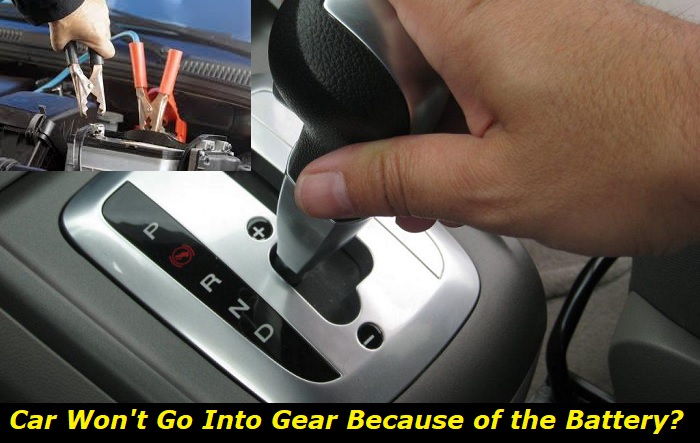There is no doubt that cars are very complicated machines. They are built differently and can develop faults when they deem fit. Will your car not go into gear after a dead battery? Here are a couple of ways to fix this.
Transmission no-shift problem highlights
- Level of importance:High
- Reasons:Control module failure, low fluid,badfluid, mechanical issues
- Needed expertise:High
- Needed tools:Professional tools set
- Time taken:5-10 hours
- Can you drive? Yes, if some gears engage
- Possible issues: Fatal transmission damage, car stationary.

A dead battery is the result of a battery losing its charge. The battery's voltage has dropped to a point where it can no longer deliver the energy required to turn over the engine's starter motor. Made simpler, it means that the battery is unable to provide the necessary electrical power needed to ignite your car's engine.
Undeniably, as a car owner, you tend to feel frustrated in the event of a dead battery or often inconvenienced. Battery charge depletion is caused by a number of issues amongst which include corrosion, extreme weather conditions, frequent short trips, and prolonged inactivity One of the resultant effects of a dead battery is a failed gear.
After fixing your dead battery, your gear can fail. To solve this issue when it occurs, you can use the following highlighted hacks and answers to FAQs.
Checking your battery - What do you need to do?
As earlier said, failed gearing can be caused by a dead or weak battery. One of the steps to fixing a failed gear is checking if your battery is charged. To do this, you can do a visual check of the device or use a multimeter.
Taking a visual cue simply means looking at the battery. To do this, open your bonnet and check if your battery is in good condition. You should also check for disconnection and corrosion.
A multimeter, on the other hand, is a handy and portable electronic device. It is used to read electrical quantities such as current, voltage, and resistance. Every car owner should get a multimeter as they are available in automobiles accessories around.
Upon discovering that your battery is dead, you can charge it using a battery charger or use a jump start.
After confirming that your battery is charged, you can proceed to ignite your engine and then change your gear. It will definitely work if it was caused by a dead battery. Voila! You are good to go.
A dead battery is one common car trouble that you might face a little too often. Undeniably, this issue often springs up at the most unexpected moment. But there is more to battery depletion than that which meets the eye.
Evaluate the shift interlock system: Here's a step-by-step guide to doing this
A failed gear after a dead battery can also be solved by inspecting the shift interlock system. A shift interlock system is also known as a shift interlock mechanism or shift lock system. It is a safety feature used to prevent the vehicle's gear shift lever from being moved out of the "Park" position unless the brake is applied.
They are found in cars that are automatic as cars with manual transmissions do not have shift interlock systems. An issue with the shift interlock system can result in failed gearing after a dead battery in an automatic transmission vehicle.
To determine if an issue with the shift lock system is the reason for your car not going into gear, here is what you need to do. Depress the brake pedal and try to shift out of the "Park" position. If you face any difficulty doing this or you are unable to complete this exercise, there is an implication of a potential fault with your car's shift interlock mechanism.
Some ways to troubleshoot and solve this fault in your interlock system include:
- Brake light switch inspection.
- Checking for objects obstructing the interlock system.
- Checking the vehicle's fuse box to see if there's any blown fuse.
- Attempting a battery reset, by disconnecting the negative terminal.
Doing all of the aforementioned to correct the error in your shift interlock system will surely help to fix your gear issue. If it doesn't, it is best to seek professional advice from an automobile mechanic. Now that your car can go into gear, won't you rather go Zoom?!
How to conduct a battery reset
Another alternative to making your car go into gear is by conducting a battery reset. In one of the earlier paragraphs, we looked into checking your battery if it is charged and in good condition. As an addendum, you can conduct a battery reset if running a visual check doesn't help to solve the issue at hand.
A battery reset is a more comprehensive solution. It is an attempt at resetting the various electronic systems and components in your car by temporarily disconnecting the battery from its source or electrical connection. Recalibration, error code restoration, and adaptive setting reset are among the reasons for battery reset.
To achieve a battery reset as a method of fixing your car's failed gearing issue, you can take the following steps:
- Step 1:The first step to take while attempting a battery reset isturning off the ignition. This should be done to prevent a spark during the disconnection process.
- Step 2:The second step is ensuring maximum safety.Taking safety precautionsis an important step that should not be missed as it is an art of preventive maintenance. Safety glasses, safety gloves or other appropriate safety gear should be worn.
- Step 3:The next thing to do is to open your car's bonnet and spot the battery.
- Step 4:Once you locate the battery, the next step to take is to identify the negative terminal. The essence of this exercise is to disconnect the negative terminal. The battery terminals are labeled negative"-"and positive"+".
To disconnect the negative terminal during the hard rest of your car's battery, you need to use a befitting terminal tool from your toolbox to loosen the nut securing the negative terminal. The negative terminal is usually black.
After loosening the nut, the next thing to do is to raise the loosened terminal's clamp from the battery post. You will then position the negative terminal apart from the battery post to avoid unintended reconnection. This exercise is followed by 15 minutes long wait.
In the end, you can then reconnect the battery by tightening the nuts back to the battery post. Waiting before a reconnection is aimed at ensuring that your car's electronic system resets, and making for the dissipation of any residual electric charge.
Finally, you should ensure that the tightened nut is perfect before igniting your car. After this reset is complete, you can then tend to your gear. Your car's gear issue after a dead battery should be fixed this way. Wait for some minutes for the purpose of your battery's recalibration and then zoom!
Calling a professional mechanic
Calling a professional mechanic is oftentimes the last rest after all DIY tips fail. Just as in this case, you can reach out to a professional mechanic when you have tried all the aforementioned tips. Do ensure to follow them holistically as the call might not be necessary if you do.
A professional hand and expertise might be all you need when your car won't go into gear after a dead battery. While on the call, be sure to clearly articulate your observations from the car to guide the expert on what to do. This surely saves more time and hastens the car assessment.
Reasons for failed gear after a dead battery
A failed gear after a dead battery has been charged doesn't happen too often. However, when it does, it is usually caused by a wrong connection, a defective shift lock solenoid, or a damaged shift cable. Other reasons may include a faulty brake switch, a low level of transmission fluid, or some other reasons best identified by a professional.
Can you avoid a gear failure after a dead battery?
Yes, it is possible to avoid a gear failure after a dead battery. This is by obeying proper maintenance practices and preventive measures. Some of these measures include maintaining your car's battery through regular checks and avoiding deep discharges. Doing these things will help to keep your battery from dying or weakening.
Ultimately, this reduces the possibility of a gear failure borne by dead or weak batteries.
To prevent a dead battery, you can do the following:
- Warm your car regularly to keep the battery charged.
- When the engine is not running, ensure all lights and electrical accessories are turned off.
- Park under a shade to stabilize the temperature.
- Replace your car's battery as and when due.
- Use a maintenance charger often if your car will be parked for long.
Do you have any questions on either of these hacks? Feel free to send them in the comment section.
About the authors
The CarAraC research team is composed of seasoned auto mechanics and automotive industry professionals, including individuals with advanced degrees and certifications in their field. Our team members boast prestigious credentials, reflecting their extensive knowledge and skills. These qualifications include: IMI: Institute of the Motor Industry, ASE-Certified Master Automobile Technicians; Coventry University, Graduate of MA in Automotive Journalism; Politecnico di Torino, Italy, MS Automotive Engineering; Ss. Cyril and Methodius University in Skopje, Mechanical University in Skopje; TOC Automotive College; DHA Suffa University, Department of Mechanical Engineering






Add comment